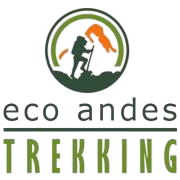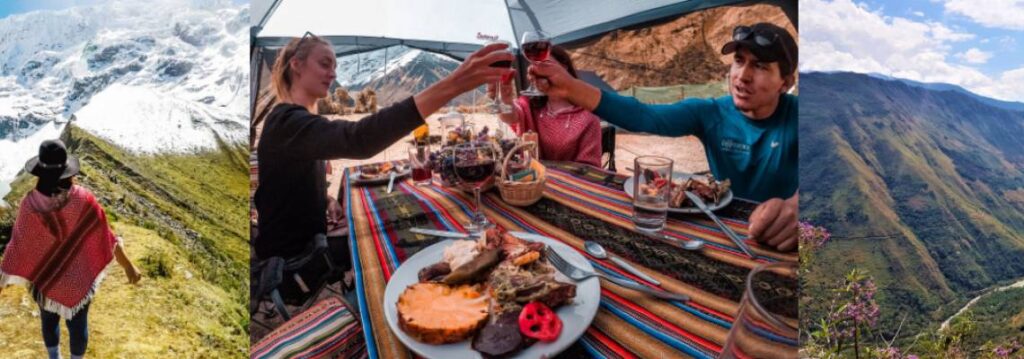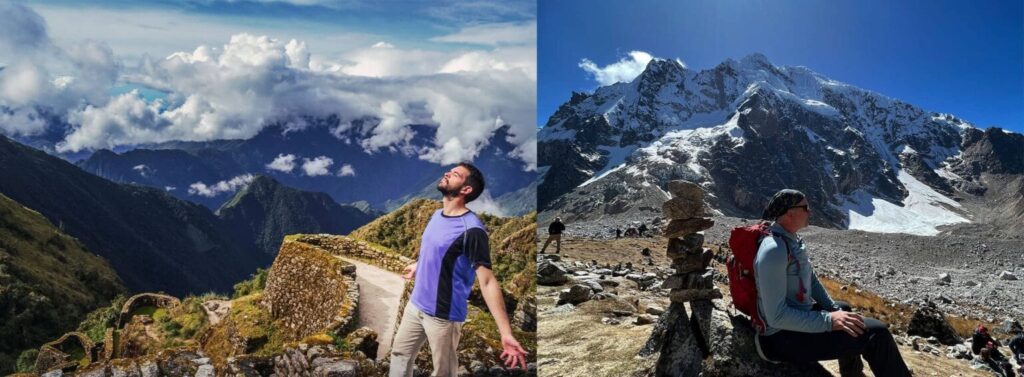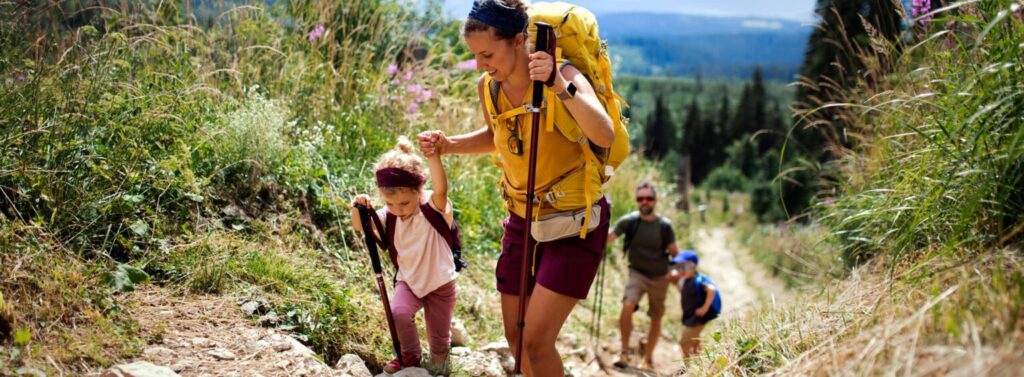
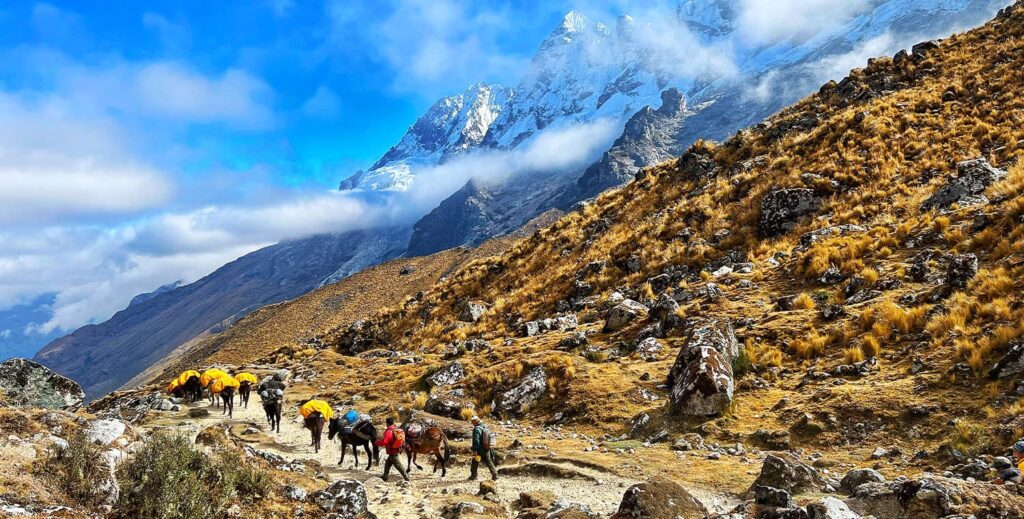
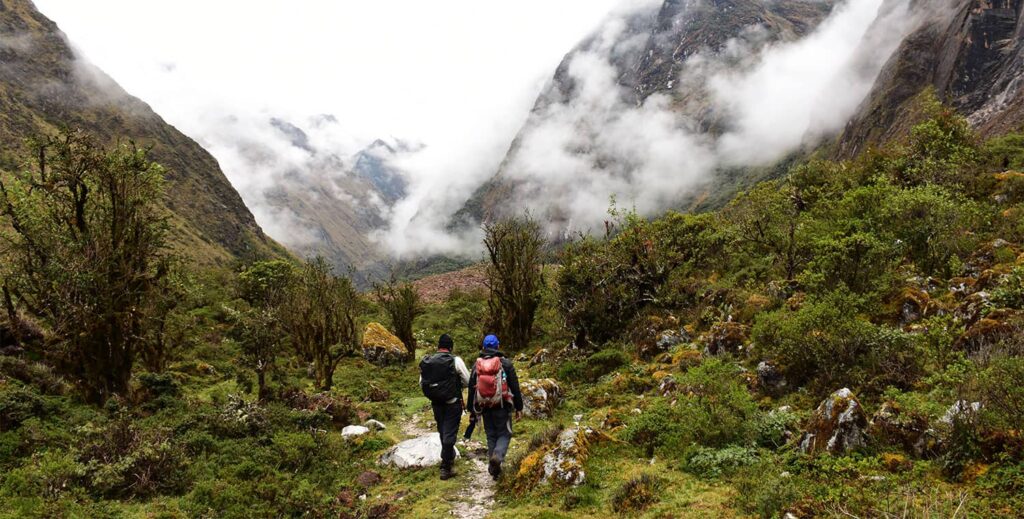
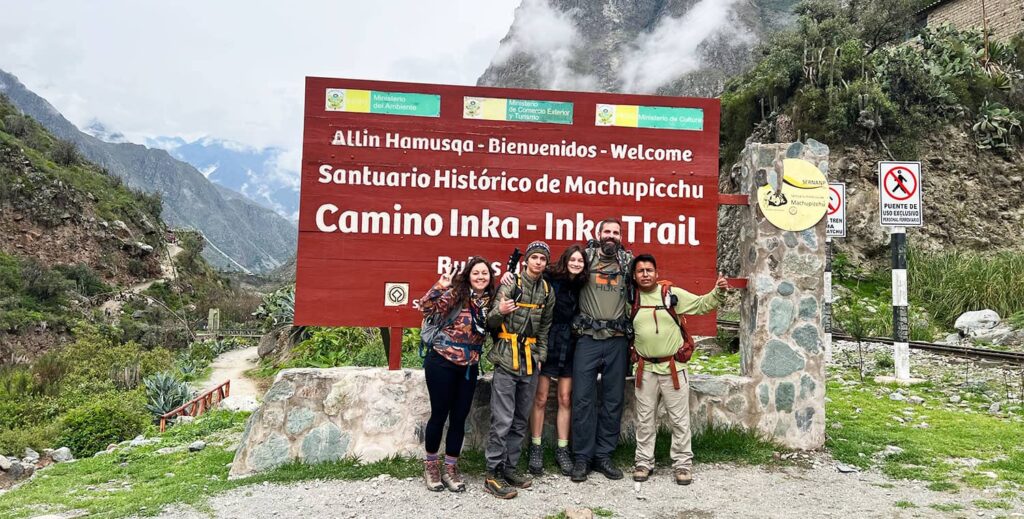
Salkantay Trek via Inca Trail – 4D/3N
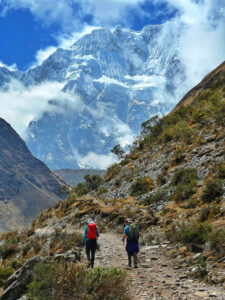 This is a very unique version of the Classic Salkantay Trek. The first two days follow one of the common Salkantay trails, but on the 3rd day we depart the Salkantay trails to enjoy a less trodden path that connects with the Classic Inca Trail. You even get the opportunity to walk a portion of the Classic Inca Trail on the 3rd day.
This is a very unique version of the Classic Salkantay Trek. The first two days follow one of the common Salkantay trails, but on the 3rd day we depart the Salkantay trails to enjoy a less trodden path that connects with the Classic Inca Trail. You even get the opportunity to walk a portion of the Classic Inca Trail on the 3rd day.
The Salkantay Trek is named for Mount Salkantay (6,271 m/20,574 feet). This Sacred Mountain is higher than any mountain in North America.
On this 4 day short Salkantay trek via Inca Trail to Machu Picchu you will see gorgeous blue lakes, stunning glaciers, a cloud forest and rain forest. The last portion of this particular trek has the ecosystem more typical of the Inca Trail with lush green vegetation and many archeological ruins. This trek is a great blend of the two very popular hikes, with an incomparable variety of flora and fauna.
The trek includes two nights of camping and one night in a hotel in Aguas Calientes.
Eco Andes Trekking is highly recommended by TripAdvisor.
Join hundreds of happy trekkers who have experienced the adventure of a lifetime!
ITINERARY
Day 1: Cusco – Soraypampa – Ichupata
We will pick you up from your hotel early in the morning and have a beautiful scenic drive of 3 hours duration to Mollepata. At Mollepata we will have breakfast at one of the local houses. During this portion of the drive we will have our first views of the magnificent Salkantay and Humantay Mountains, as well as observe lush vegetation and the fields of local families growing potatoes, quinoa, lima beans, etc.
At this point we will arrive at Soraypampa (3,800 m/12,467 ft), the trailhead for the Salkantay trek, and meet our support staff, who will pack everything for the trek and load the equipment onto horses.
The first thing we will do is hike up to the magnificent Umantay Lake. After enjoying the beauty and taking pictures, we will hike back down to Soraypampa and “officially” begin the trek.
The hike today is uphill from Soraypampa to Ichupata (4,300 m/14,104 ft) in the upper valley. This is a 5 to 6 hour hike. Along the way we will pass Salkantaypampa, our lunch spot.
Ichupata is our camp for the night. When we arrive, we will settle in, have happy hour and a hearty dinner.
- Meals: Breakfast/Lunch/Dinner
- Distance Covered: 12 km / 7.5 miles
- Approximate Walking Time: 5-6 hours
- Lowest elevation: 3,800 m/12,467 ft
- Highest elevation: 4,300 m / 14,104 ft
- Level of Difficulty: Challenging
Day 2: Ichupata – Incachiriasca – Pampacahuana
After a savory breakfast, we will begin the 3 to 4 hour steep climb to towards the Incachiriasca pass (4850 m/15908 ft), the highest of the entire route.
We will have amazing views of Apu Salkantay and glacial moraines during this portion. We will pause at the top of the pass to take pictures and enjoy the magnificent view.
We will then descend towards our lunch spot at Sisaypampa, a flat area from which one can observe the neighboring Salkantay Valleys. This is a place where we might see Andean condors.
After lunch we continue towards the Pampacahuana community (3,700 m/12,136 ft), located next to an original Inca canal. This is our camp for the night.
- Meals: Breakfast/Lunch/Dinner
- Distance Covered: 14 km/8.5 miles
- Approximate Walking Time: 8 hours
- Lowest elevation: 3,700 m/12,136
- Highest elevation: 4,850 m/15,908 ft
- Level of Difficulty: Challenging
Day 3: Pampacahuana – Paucarcancha – Huayllabamba – KM 82 – Ollantaytambo – Aguas Calientes
Today we change pace as we join the Classic Inca Trail. We begin by hiking downill for 2 hours from Pampacahuana to Paucarcancha (3133 m/10,276 ft). We will visit the Inca site of the same name.
After the tour we will hike downhill for 5 hours until we reach KM 82, which is the start of the classic Inca trail. Along the way we will be able to see the Inca site of Llactapata.
This is the first site on the Classic Inca Trail. Our chef will make us a delicious lunch at KM 82.
After lunch we will be picked up by a local transportation at KM 82 and transported to Ollantaytambo (2,792 m/9,158 ft) where we will catch a nice train to Aguas Calientes.
When you reach Aguas Calientes you will check in to your hotel room. The natural hot springs in town are a great place to relax if there is time before dinner. Dinner will be at a local restaurant.
- Meals: Breakfast/Lunch/Dinner
- Lodging: Hotel
- Highest Elevation: 3,700 m/12,136 ft
- Lowest Elevation: 2,792 m/9,158 ft
- Distance to walk: 16 km/ 10 miles
- Estimated walking time: 6.5 to 8 hours
- Level of Difficulty: Easy
Day 4: Aguas Calientes – Machu Picchu – Cusco
You will have breakfast at your hotel before we take an early bus along the winding road to Machu Picchu, the city that was lost to the jungle but rediscovered in 1911 by Hiram Bingham. Declared a UNESCO world heritage site in 1983, Machu Picchu exceeds all expectations.
Perched high on an inaccessible hilltop the citadel is protected by huge cliffs and the raging Urubamba River. Once there you will be given a 2 hour walking tour of the site.
After you have concluded your Machu Picchu tour, you will have some time to be at Machu Picchu before you return to Aguas Calientes by bus.
When you arrive in Aguas Calientes you will board the expedition train to either Ollantaytambo or to Poroy.
From Ollantaytambo or Poroy, you will travel by private van to Cusco and we will drop you off at your hotel. Arrival time in Cusco depends on the time of your train ticket.
- Meals: Breakfast
- Lowest Elevation: 2,040 m/6,691 ft
- Highest Elevation: 2,440 m/8,052 ft
INCLUDED:
- Bilingual English speaking tour guide
- Pre-Departure Briefing at your hotel 1 or 2 days before your trek
- Pick up from your hotel and transportation to Soraypampa
- Four person tent for each 2 persons.
- Mattress and pillow
- Kitchen tent
- Dining tent with tables and chairs
- Toilet tent
- Professional chef and assistant chef
- Wranglers, porters and horses to carry all the equipment (food, tents, chairs, table, etc) and eight kg (15 lbs) per hiker for your own belongings
- Duffle bag for your personal gear
- Emergency horse in case we need it
- Four breakfasts, four lunches, and three dinners
- Twice daily hot water for washing.
- Daily morning boiled and cold water to fill the water bottles.
- Expedition train ticket from Ollantaytambo to Aguas Calientes
- Expedition return train ticket from Aguas Calientes to either Ollantaytambo or to Poroy
- Private van transportation from Ollantaytambo to your hotel in Cusco
- Emergency oxygen bottle, medical kit and emergency satellite radio
- Entrance to Machu Picchu
- Round Trip Bus ticket from Aguas Calientes to Machu Picchu on Day 4
- Lodging in Aguas Calientes on night 3 of the trek (double occupancy)
- Dinner in Aguas Calientes on Night 3
NOT included:
- Sleeping bag – you can rent one from us
- Trekking poles with rubber tips- you can rent from us
- Huayna Picchu Permit (this ticket can be purchased for an extra USD $75 per person)
- Day 4 Lunch in Aguas Calientes
- Tips for the crew (guides, porters, cooks, wranglers)
- Travel Insurance
What to bring:
- Original passport (if you have acquired a new one after you made your booking, bring both)
- Down or synthetic feather sleeping bag (can be rented from us)
- Clothes (trekking boots, warm fleece jacket, a few T-shirts, socks, sun hat, warm underwear, light long pants, gloves, rain jacket)
- Toiletries (toilet paper, wet wipes, personal towel)
- Sunscreen SPF 35+ recommended
- Head lamp, batteries*
- Sunglasses
- Camera, spare batteries*
- Binoculars
- Trekking poles with rubber tips (recommended especially for the steep descents (can be rented from us)
- Insect repellant (minimum 30% DEET)
- NOTE *batteries run down faster at high altitudes
PRICES & ADD-ONS
Group: USD $690 per person
Private: USD $750 per person
Group versus Private Treks: What’s the difference?
- Depending on the number of people in your booking, additional people may join the trek to make a full group.
- If you choose “private”, no additional people will be joining your group, no matter the size.
- Minimum booking size is two people; one person may book a group trek if Eco Andes Trekking is able to join that person with additional groups.
Rentals
- Hiking Poles – USD $20 (pair)
- Sleeping Bag – USD $25 per person
- Private Tent – USD $30 per person
Upgrades
- Return Vistadome Train – USD $60 per person
- Return Hiram Bingham Train– USD $420 per person
- Sumaq Machu Picchu Hotel (5-star hotel) – USD $255 per person per night (double occupancy)
- Inkaterra El Pueblo Machu Picchu Hotel (5-star hotel) – USD $250 per person per night (double occupancy)
- El Mapi Hotel by Inkaterra (4-star hotel) – USD $115 per person per night (double occupancy)
- Tierra Viva Machu Picchu (3+ star hotel) – USD $50 per person per night (double occupancy)
Discounts
- Under 18 years Discount: USD $20
- Under 7 years Discount: USD $35
Salkantay Trek via Inca Trail to Machu Picchu 2024 FAQs.
What is the 4 day Salkantay trek via Inca Trail to Machu Picchu?
The Classic Inca Trail is famed for the diversity of its topography and ecosystems; the Salkantay Route’s smorgasbord is even more impressive!
The 20,500-feet-high Mount Salkantay was one of the holiest apus, or sacred peaks, in the Inca religious pantheon.
It’s still revered today in traditional Andean religion. This mule-assisted hike cuts through the beautiful Mollepata Valley and traverses Incachiriasca pass at an altitude above 15,908 feet.
From those chilly heights, the trail descends into subtropical cloud forest, where it meets up with an ancient Inca highway that leads to the recently rediscovered ruins of Llactapata.
The trek ends at the KM 82 (start of the Classic Inca Trail to Machu Picchu), where a local transport awaits for us to take us to Ollantaytambo. Here, we will use the train runs along the Urubamba River to Aguas Calientes, the town located at the base of Machu Picchu.
Why the 4 day Salkantay trek via Inca Trail to Machu Picchu is becoming popular?
The Salkantay route is the most popular alternative trek to the Inca Trail. It features diverse ecosystems including cloud forest, rain forest and high mountain. You will have stunning views of snowcapped glaciers and a strikingly blue lake (Umantay lake).
The trek is named among the 25 best treks in the World, by National Geographic Adventure Travel Magazine, is a trek open to everybody.
A permit is not required for the Salkantay via Inca Trail Trek and start dates are flexible.
It is best though to book your trekking trip in advance, especially during the high season (May to September), to assure reservations for daily excursions and at desired hotels in destinations you visit before and after the trekking experience.
How far in advance should I reserve my permit for this trek?
Unlike the Classic Inca Trail, where there is a limit of 500 hikers per day and so permits can be sold out up to six months in advance, there are no limits for hiking the Salkantay via Inca Trail trek to Machu Picchu.
This makes it an excellent alternative if you’d been hoping to hike the Classic Inca Trail but have found that there isn’t any space.
The only restriction you’ll face is on the availability of entry tickets to Machu Picchu, so it’s still worth booking at least a few weeks in advance, particularly if you’re travelling between May and September.
Is a permit required to hike the Salkantay Via Inca Trail to Machu Picchu?
No permits are currently required to trek the Salkantay via Inca Trail hike. However, you will need a ticket to enter Machu Picchu at the end of the trek. Also, if you plan on hiking any of the three mountain trails within Machu Picchu, you will also need to buy these tickets in advance too.
Again, be mindful, that tickets for Huayna Picchu sell out months in advance, as there is a limit of just 200 people per day. So, you may need to be a little more organized than usual if you plan to hike this trek.
Does the Salkantay trek cost include your Machu Picchu entrance ticket?
Yep, the cost of entry is included in the trip price and it’s the responsibility of Eco Andes Trekking to take care of all that and provide you with the ticket on the day you’re entering the site.
Is there a waiting list for sold out Machu Picchu permits?
No, there is no waiting list for permits. Permits are only available for purchase through the Peruvian government.
Once a permit is purchased for one person, the permit cannot be refundable or transferred to another individual.
Is it possible to enter Machu Picchu with a different name?
No, you need to carry your valid passport to enter the city.
What is the terrain like? And how difficult is the Salkantay to Machu Picchu?
The difficulty of 4 day Salkantay via Inca Trail hike to Machu Picchu is “Moderate – Challenging”.
The 4 day Salkantay hike is around 42 km (26 miles) long. For travelers interested, you must be physically capable for a trek like this.
Altitude effects aside, it is multiple days of 6+ hours of hiking through rough terrain and often up or down hill. But anyone who exercises regularly will manage just fine! It is exhausting but it’s certainly not unbearable.
All guides carry oxygen canisters, so if you start to feel altitude sickness you can rest and get some much-needed O2. If you’re an avid hiker or used to the altitude you won’t have a problem.
For everyone else, make sure you feel confident in your hiking abilities and you’ll do great.
Which campsites do you use along the trek?
Campsites may change depending on booking time and availability, weather conditions or on restrictions undertaken for safety reasons by our trekking team.
We generally try to camp in less trafficked areas so that trekkers can enjoy the natural beauty of the trek and minimize environmental impacts. Our regular campsite choice is Ichupata and Pampacahuana.
What do I need to carry on the trek?
We recommend that travelers carry the items that they will need each day while hiking such as water, snacks, camera and film.
Our horses will carry 8 kg of each of your personal gear including the camping equipment during the trek. We will give you a duffel bag for those belongings at the time of your pre trek briefing.
We generally ask trekkers to bring only the necessary items that they will need for the trail and leave any unneeded luggage at the hotel in Cusco or at our office.
Where do I store my luggage during the Salkantay via Inca Trail hike?
Your Cusco hotel will store your luggage for free while you will be on the trek. We can also store your extra luggage at our office in Cusco at not any extra cost.
How big are the groups?
Our groups are usually small. Average is 3 to 5 people and maximum 16 people plus the trekking team.
When Is the Best Time to Hike the Salkantay to Machu Picchu?
The end of the rainy season (April) and the beginning of the dry season (May) are generally considered the best times to hike the Salkantay to Machu Picchu.
The surrounding landscape is still green and lush from months of downpour and the chances of being caught out in the rain are significantly lower.
Is the Salkantay via Inca Trail trek to Machu Picchu always open?
It’s possible to trek the Salkantay hike all year round, but for the best conditions (and to get those iconic views at Machu Picchu on the final day), try to avoid the rainy season, which is between November and March.
Are there toilets and showers at the campsites?
We provide you with a popup tent toilet that is clean and sanitary.
There are toilets built in the Salkantay trek including all of the major campsites, however, they can be a bit disgusting.
Each bathroom block has cold running water. We recommend that you bring a hand-sanitizer to use after visiting any toilet.
Altitude and acclimatization
We recommend travelers spend a few days in Cusco before doing the trek to help adjust to the high altitude.
It’s better to acclimatize in Cusco, not the Sacred Valley, because the higher elevation of the city at 11,120 ft (3,400 m) is more akin to those at the start of the Salkantay trek.
Altitude sickness is caused by a rapid change in elevation without the necessary time for acclimatization.
Mild symptoms are common and include lingering headache, nausea, and loss of appetite. Every person responds differently to the change in altitude and unfortunately there is no way to prevent it or predict how seriously it may affect you.
What is the food like on the Salkantay via Inca Trail hike?
A cook accompanies each group on the trek and prepares breakfast, three course lunches and dinners.
The meals are quite exquisite considering that all of the ingredients and cooking supplies are carried from Cusco and the Sacred Valley.
Each trekker is also provided with snacks to take with them on the trek. Vegetarian and vegan meals are also available upon request. Other special dietary requests can usually be accommodated as well with sufficient notice.
Is drinking water supplied?
Yes, our trekking team will provide drinking water every morning and at each meal. Each evening, water is collected from nearby streams, boiled, and left to cool overnight.
A reusable water bottle or hydration pack works well for this. We recommend that travelers bring their own refillable bottles to limit plastic waste along the Trail.
What equipment is supplied by us along the trek?
We supply the sleeping tents (4 person tents for two travelers), dining tents, tables, chairs, toilet tents, cooking equipment, water purifiers, sleeping pads, and other camping equipment.
Our outfitter purchases the highest quality equipment in Peru and older equipment is evaluated and replaced on a regular basis.
What are the guides like?
Our team are among the very best and most experienced guides anywhere. They are from the surrounding Cusco and the Sacred Valley areas and speak fluent English, in addition to Spanish and the Inca indigenous language of Quechua.
Most have 8-10 years of experience leading hikes to Machu Picchu and all have training in the history, spirituality, culture, and ecology of the area.
How can I prepare for the Salkantay via Inca Trail trek?
The more training you do beforehand, the more you will enjoy your trek.
We recommend 30 minutes of cardio activities 3-4 times a week in the 2-3 months leading up to your departure. Take every opportunity to walk up and down stairs or hills for leg strengthening and aerobic fitness.
Are there any ATMs?
There are no ATMs along the Salkantay via Inca Trail trek. You should bring enough money with you from Cusco for tipping and lunch in Aguas Calientes.
There are also some ATMs in Aguas Calientes if you need to withdraw additional cash.
What if I have a medical emergency while hiking the Salkantay via Inca Trail trek?
Guides carry a first aid kit for basic medical problems (traveler’s diarrhea, cuts/scrapes, etc.). They receive Red Cross First Aid and other emergency training every year.
Our guides lead over 1000 travelers along the trek each year and we have rarely had a traveler unable to complete the hike.
In these rare instances when someone has not felt well enough to finish the hike, the client has been escorted back to Cusco and generally felt well enough to re-join the group in Machu Picchu via train a few days later.
Cusco city has the nearest modern medical facilities so travelers with a serious medical emergency would need to be evacuated there.
Guides and porters have pre-established evacuation strategies in place should this need occur.
Is there internet access on the Salkantay via Inca Trail trek?
Wi-Fi is available based on weather conditions at the second camp.
Sometimes this is just a matter of paying a few coins for the local password and of course, there is internet service once you reach at Aguas Calientes town on the afternoon of day three
How much money should you bring on the Salkantay via Inca Trail trek?
The vast majority of costs will be covered in the up-front price of your trip, but there are a few costs along the way for which you’ll need to bring cash:
- Snacks and drinks from stallholders
- Toilet entry fees (usually 2 soles at Machu Picchu)
- Tips for porters and guides
- Lunch on day 4 at Aguas Calientes.
It’s sensible to take this money in the form of smaller notes and coins.
We’d say at least 400 soles per person for the Trek-specific section.
Will I get altitude sickness on the Salkantay via Inca Trail trek?
Many of the most popular places in Peru, such as Cusco and Huaraz, are at high altitude; this means that for anyone planning a trip to Peru understanding altitude sickness (and how to avoid it) is incredibly important. In fact, not approaching altitude correctly is one of the biggest mistakes of travelers in South America.
The best way to minimize the likelihood and impact of altitude sickness is factoring in enough time into your Peru itinerary to acclimatize to the conditions.
This means that it is incredibly foolish to arrive in Cusco, which is at 3,399m (11,152 feet) above sea-level, and leave the next day to do a strenuous hike or even start the Salkantay trek. Your body needs the time to adjust to the altitude!
A good rule of thumb is to give yourself and your body two easy days at altitude to acclimatize to the change, and to keep yourself well hydrated throughout.
What about medication?
Obviously, medical attention and facilities along the trek are pretty much non-existent so you need to bring any of your own required medication with you and keep it on your own person or in the daypack.
What climates can I expect on the Salkantay trek?
Variance in latitude, elevation and local winds all factor into the wide range of climates experienced in the central Sierra Mountain region.
Average temperatures in the Sierra vary little between seasons, but there is dramatic daily variance.
While the average daily temperature may only vary a few degrees Celsius between January and July, the diurnal (daily) temperature range is often huge.
You can expect daytime temperatures in the highlands to be in the range of 10-25°C (50-77 °F), falling as low as -10 °C (14°F) at night especially at the first camp site.
How much time can I spend at the Machu Picchu sanctuary?
There are three time slots in which patrons can enter Machu Picchu for a maximum of four hours and must follow one of three predetermined routes.
Admission is not allowed after 4pm. Additionally, all visitors must always be accompanied by a guide.
The early morning is one of the best times to savour the views and atmosphere of Machu Picchu. The mystical morning light over the enigmatic sites is spectacular.
Try and catch the sunrise at the sanctuary, you won’t regret the early wakeup call!
PRICE PER PERSON IN USD:
Group: $690
Private: $750
DURATION:
4 Days / 3 Night
AVAILABLE ADD-ONS
- Hiking Poles – USD $25 (pair)
- Sleeping Bag – USD $30 per person
- Huayna Picchu Permit – USD $75 per person
- Return Vistadome Train – USD $60 per person
- Return Hiram Bingham Train– USD $420 per person
- Sumaq Machu Picchu Hotel (5-star hotel) – USD $255 per person per night (double occupancy)
- Inkaterra El Pueblo Machu Picchu Hotel (5-star hotel) – USD $250 per person per night (double occupancy)
- El Mapi Hotel by Inkaterra (4-star hotel) – USD $115 per person per night (double occupancy)
- Tierra Viva Machu Picchu (3+ star hotel) – USD $50 per person per night (double occupancy)
- Private Tent – US $40 per person
OVERVIEW
- Day 1: Cusco – Soraypampa – Ichupata
- Day 2: Ichupata – Incachiriasca – Pampacahuana
- Day 3: Pampacahuana – Paucarcancha – Huayllabamba – KM 82 – Ollantaytambo – Aguas Calientes
- Day 4: Aguas Calientes – Machu Picchu – Cusco
- Beginning altitude: 3,800 m / 12,467 ft
- Maximum altitude: 4,850 m / 15,908 ft
- Hike Total Distance: 42 km/ 26 miles
- Overall trek difficulty: Challenging
INQUIRE ABOUT THIS EXPERIENCE
WHY WE'RE DIFFERENT
Your Full Satisfaction or Your Money Back
We understand planning a big trip like ours at APT takes a lot of trust, and we’re here to make sure that trust pays off from the moment you book to the day your adventure wraps up. We’re fully committed to making your experience unforgettable. If something doesn’t go as planned—whether it’s an issue with the service or something unexpected along the way—we’ll step in to fix it.
That even includes offering a refund if needed so you can book with total peace of mind.
Your Peruvian adventure means the world to us, and we’ll go the extra mile to make sure it not only meets but exceeds your expectations. With our satisfaction guarantee, you can relax and focus on taking in all the incredible beauty and culture Peru has to offer.
We Help You Experience Peru Through The Eyes of a Local
We’re 100% locally owned and operated, with guides, porters, and chefs who grew up in the Cusco region. Fluent in Spanish, English, and Quechua, our team brings unmatched cultural and historical knowledge to share with you. Traveling with us means gaining insight into Peru’s traditions, landscapes, and stories from those who know them best.
We Work With Professional Guides Who Provide Exceptional Service
Our guides are the best of the best. Truly skilled experts with at least 5 years of experience, every guide we employ is ready to share their expertise on Peru’s trails, culture, and history. Our porters are no exception. They work hard to make your journey one for the books, while our chefs will prepare you delicious meals along the way. With a 99% recommendation rate, we’re dedicated to making every detail of your trip unforgettable.
We’re Committed to Our Team
Our porters and horsemen are easily the backbone of every trek. That’s why we are fully committed to prioritizing their well-being. We ensure they’re paid above-average wages—higher than those offered by most tour companies—recognizing their hard work and dedication to the team. Beyond fair pay, we truly care for their well-being, providing proper gear, meals, and working conditions so they’re not just safe but comfortable, too.
We Look Out for Our Community
A portion of every trek we sell supports local projects, like helping fund a much-needed school roof in Sacsayhuaman, where many of our team live. For years, children in the area had no nearby school and faced grueling four-hour walks in harsh conditions to get an education. Today, thanks to these contributions, they have a local school, and we continue to donate to its upkeep—because making an impact goes beyond the trek.
We Customize Our Adventures to Suit Your Travel Style
We want every trip to feel like it was made just for you. Whether you’re keen on hiking the famous Inca Trail, exploring lesser-known spots in the Sacred Valley, or tackling our one-of-a-kind Ancashcocha + Inca Trail trek, we’ll plan your adventure to fit your travel style. To keep things personal, we keep group sizes small—and if your group is larger than eight, we’ll bring in an extra guide so no one misses out on the experience.
We Travel with Purpose – Serving the Women, Children, & Men of Peru
Every journey with us has a ripple effect. Your adventure supports ethical tourism, fair wages for porters, and opportunities for female trekkers–many of whom are breaking barriers on the Inca Trail–and children. We’re passionate about creating opportunities for local children to grow up healthy and learn about everything their heart desires. Through initiatives like repairing schools, donating educational materials, and funding projects, we make it a mission to build a brighter future for kids in the Cusco region. Every trek you take with us contributes to this mission. When you book with us, you’re not just exploring Peru; you’re investing in it and setting a standard for all other tourism companies and tourists.
Our Reputation is Built on Trust
Year after year, Eco Andes Trekking has earned top ratings on TripAdvisor and the prestigious Certificate of Excellence. We’ve worked hard for these awards and are proud to see our hard work recognized. Even prouder to know our travelers leave with unforgettable memories and stories worth sharing.
We Travel Sustainably & Responsibly
Peru’s landscapes are magnificent. That’s why we work so hard to protect them. We prioritize sustainable traveling by working with our local communities and employing indigenous guides––thus promoting economic empowerment and preserving cultural heritage. Along the journey, we’ll always encourage travelers to embrace responsible practices as advocates for the environment.
